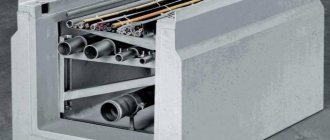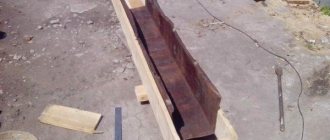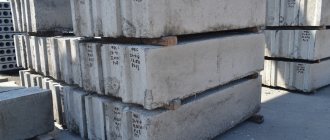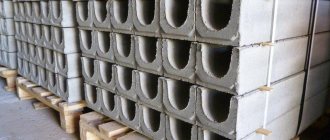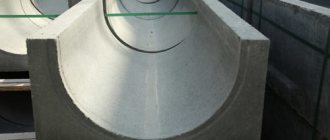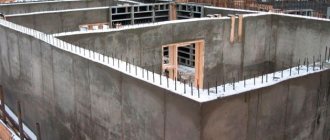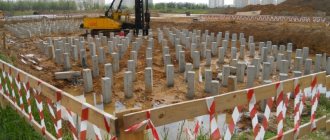Definition and scope
photo of a road concrete drainage tray
Reinforced concrete trays are used for installation of heating mains in ground conditions. There are special requirements for the strength of such products, so the trays are made of heavy concrete and heavy-duty steel of categories Bp-1 and A-1. The main purpose of using a reinforced concrete tray is to lay a utility network.
In addition, the trays accumulate air around the heating main, promoting energy saving, and also protect the networks from destruction under the influence of groundwater. The classification of such trays is carried out depending on the type of design, assembly process and functional purpose.
For example, edge trays are widely used for prefabricated drainage structures serving highways. From the name of these structures it is easy to understand that they are mounted along the edges, and the main purpose of their use is to effectively drain water to the slopes of the roadway.
How to make a tray? Step-by-step instruction.
If you decide to make a drainage tray with your own hands, then you should act in the context of the following diagram:
- You should start by preparing the molds for pouring. Contrary to popular belief, they can be not only metal, but also polymer. It is extremely important to thoroughly treat the inner walls of the mold with machine oil. After lubricating the mold, it is necessary to secure the reinforcement in it;
- The parts of the reinforcement should be fastened not only relative to the shape, but also relative to each other. As a rule, this stage of work is carried out using gas or electric welding.
- The molds should be fixed before pouring begins; even slight movement of the selected containers is considered unacceptable and may not have the best effect on the quality of the finished product.
- After a week, you need to carefully remove the formed channel from the pipe; if necessary, you need to cover it with a layer of paint or any anti-corrosion compound that is not rough after drying. This will help improve the efficiency of the sewer system due to the smooth internal structure.
This video shows an artisanal manufacturing method.
Even with total adherence to the described technology, the service life of a tray made at home may differ significantly from the period of operation of a factory product, which in itself is logical. However, if you follow the described scheme, the tray you make will not be inferior to the one that was made in the factory in terms of efficiency during operation.
Let's see how to make a U-shaped block for water drainage
Roads for cars and auxiliary units on their territory seriously suffer from the destructive effects of precipitation and other atmospheric factors. Precipitation in the form of rain seriously changes the mode of operation of roads, so its effective and timely drainage plays a fundamental role.
The maximum harm to the stability of the structure is caused by the so-called. free water. The operation process is accompanied by significant fatigue of road surfaces, destruction of expansion joints, and the appearance of cracks. In order to delay this process as much as possible, drainage structures are used.
Online services
Online selection of trays
Standardpark specialists have developed a convenient and reliable calculator. Now you can easily and quickly select drainage trays from the desired material and size in a matter of seconds.
Calculator for calculating sealant
Calculate the required amount of sealant to seal linear or point drainage systems using our convenient calculator.
Complete professional technical solution for the site
The Standardpark design service offers a technical solution to the problem of draining surface runoff, flooding the foundation, and calculating domestic sewerage. Individual approach to designing your site.
Installation diagrams
Example of installation in asphalt concrete pavement
Example of installation at the edge of a curb
All installation diagrams
You can buy concrete trays from Standardpark here on the website or sales offices, including ordering a design solution for installing a surface drainage system on your site. If you need advice or find out additional information, please contact us!
How are drainage trays installed? Installation process from A to Z.
Video about installing concrete trays on the highway
The optimal installation option for trays is determined by the expected operating conditions. In this case, the classic installation option looks like this:
- 1. At the first stage, trenches are dug. Their size should provide space not only for trays, but also for subsequent pouring of concrete on both sides.
- 2. The bottom of the trench is strengthened with a mixture of sand and crushed stone.
- 3. Raw concrete is poured over the sand cushion.
- 4. Containers are placed on top of the concrete and immediately filled with concrete on the left and right for additional fixation.
- 5. The trays are fixed into a single structure using grooves.
Engineering features and equipment
Concrete tray for water drainage from the manufacturer Standardpark can be with vertical or horizontal drainage. In areas where there are problems with the possible depth or organization of liquid flow by gravity - channels with an internal slope (from 5 to 50 mm). Sold in sets.
The kit includes:
- a tray with reinforcing attachments pressed into the body of the gutter (can be made without metal attachments - upon request);
- 2 cast iron grates 500 mm long (allow storm drains to pass through, protect against clogging and ensure safe movement);
- fasteners (bolts and nuts).
Procedure for drainage from dividing strips
The drainage of surface water from highway strips, testing sites and embankments exposed to groundwater is characterized by a list of individual characteristics. Most often, they are caused by strictly individual contours of runoff directions in the plan, the presence of looped runoff areas and ramps with large-scale multidirectional slopes, proximity and interaction with the city territory, etc.
drainage of water from trays
The branches of transport arteries require the most efficient drainage of water and its redirection beyond the road surface. Drainage systems must provide a stable, unimpeded flow of liquid, directing it along a longitudinal slope in the required direction. If the exit ramps of highway interchanges cross embankments, then special throughput pipes are used for drainage.
At this point in time, when arranging drainage from road sections and bridges, the following schemes are especially popular:
1. Scheme No. 1 is used to service sections of highways, the total number of lanes on which does not exceed six. In the context of this surface drainage option, flows move parallel to sidewalks and are discharged into slope-type containers, or less often into closed-type sewers.
drainage of water from the bridge
2. The second scheme, widely used on large bridges and overpasses with a significant width of the deck, involves a water drainage system using transverse outlets through special channels and blocks on the sidewalks under the bridge or overpass, and in some cases through water storage tanks with further transportation to the drainage network .
It is important to understand that the water drainage system is selected and assigned in each individual case individually, taking into account the specifics that are observed in a given area.
If railways or highways intersect, there is an urgent need to discharge water into the sewer system in order to avoid pollution of transport routes. In areas where flooding is common, it is very important to ensure that the underbridge cones are as stable as possible. As a rule, cement or reinforced concrete is used to strengthen them.
Table 1 - Tray classes
| Load class/Mounting group | Bearing capacity (test load value), kN | Recommended tray type |
| JSC Group I | — | Types 1, 2 |
| A15 group II | 15 | Types 1, 3 |
| B125 group III | 125 | Types 3, 4 |
| C250 group IV | 250 | Types 3, 4 |
In the Moscow region, asphalt concrete is widely used as a reinforcing material. This type of construction is distinguished by excellent waterproofing qualities and in this sense is significantly superior to structures made from concrete slabs.
In addition to those methods of strengthening, which have already been discussed above, gutters, long-length trays and frame trays are widely used. In the vast majority of situations, they turn out to be prefabricated and are produced only in factory conditions. A special need for the use of such trays arises in cases where the soil in the area where the object is being constructed is saturated with liquid and is not stable. It is important to note that such elements are used only for drainage and are not allowed to be used for strengthening.
grade of concrete and dimensions of concrete trays
Surface runoff, which plays a significant role in the formation and replenishment of rain flow, is characterized by minimal single- and double-slope slopes that do not have a channel. Contrary to popular belief, their origin can be not only artificial, but also natural. The water absorption coefficient is determined by the type of existing coating, roadside reinforcements, dividing strips and soil types on the natural slopes of the adjacent territory. Speaking about artificial coatings, it is worth saying that in the vast majority of cases their shape turns out to be rectangular, which in itself is quite logical.
Table 2 - Geometric dimensions of trays and maximum deviations
In millimeters
| Name of internal size | Maximum deviation | |
| External tray height up to 500 incl. | External height of the tray St. 500 | |
| Length: | ||
| up to 1000 incl. | ±2 | ±4 |
| over 1000 to 4000 incl. | ±4 | ±8 |
| St. 4000 | ±5 | ±10 |
| Width: | ||
| up to 500 incl. | ±2 | ±3 |
| St. 500 | ±3 | ±5 |
| Height (diameter): | ||
| up to 200 incl. | ±2 | ±3 |
| St. 200 | ±3 | ±5 |
In addition to hydraulic structures, there are agrotechnical and forest reclamation facilities on the territory of the Russian Federation, however, each of them has significant drawbacks. The former are effective only on those slopes whose steepness does not exceed 4 degrees, while the latter become effective no less than 12 years after installation.
Discharge of liquid sediments and groundwater through the upper points of ravines using rapid flows and cantilever-type spillways. The adjustment is carried out using earthen ramparts; specially equipped channels are used to drain water from retention structures.
In the process of fixing ravines, as well as during forced intersections of ravines and transport highways, it is necessary to equip bottom facilities to combat erosion. To prevent erosion, dams and dams in general, these structures justify themselves by demonstrating high efficiency throughout their entire service life.
Concrete drainage trays with grating
Concrete trays with gratings are a drainage device, the main task of which is to eliminate excess rainwater from, first of all, poorly absorbent surfaces. For example, asphalt roads, paved pedestrian areas. Whereas the grate has a slightly different task - to protect the drainage system from clogging with large debris that water carries with it. Soaked paper, branches, leaves - all these seemingly harmless materials tightly clog the storm drain and sand trap, dooming the area to local flooding. In addition, concrete drainage trays with gratings are significantly safer than their open counterparts, since they completely eliminate the risk of injury to an unwary pedestrian.
Modern concrete trays are made by vibration pressing or casting. Such production methods are not only technologically advanced, but also allow you to maintain ideal geometry, literally stamping concrete products.
Thanks to careful selection of the mixture for vibrocompression, it is possible to obtain a homogeneous concrete structure. Which also has a positive effect on the mechanical strength of the product.
Drainage trays are provided with various types of protection from debris, but the most popular are concrete trays with a cast iron grate. The reason for this popularity is simple - the high strength of the product. The strength classes of concrete drainage systems reach F900 with a permissible load of 90 tons per square meter. Such trays are used in places with enormous mechanical load - airports, highways, ports. It would be strange if, under such loads, the lattice did not meet the strength class of the entire product.
A high-quality concrete tray has the following positive aspects:
- Low hygroscopicity;
- High mechanical strength;
- Frost resistance;
- High number of defrost/freeze cycles.
Another undeniable advantage that concrete trays with gratings have is the price, which does not bite. The cheapness of such trays is achieved not due to a decrease in product quality, but due to the availability of production raw materials, as well as production technology, which can significantly reduce production time due to the high viscosity of the pressing mass. Due to this, the production of a tray takes a matter of minutes, depending on the hydraulic section and strength class. In addition, ease of production allows you to expand the range of trough gutter profiles. So, in addition to the usual “straight” gutters, drainage systems with a built-in slope of the gutter are popular.
Buying a concrete tray with grating in our store is not difficult. If you value your time and spare your wallet, then this will be the right decision. Our company’s specialists, having extensive experience in creating drainage systems, provide consultations, help in selection, and also provide assistance in carrying out the necessary calculations. Our delivery service operates throughout Russia, delivering high-quality drainage systems to construction sites from Vladivostok to Kaliningrad.
